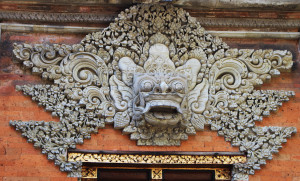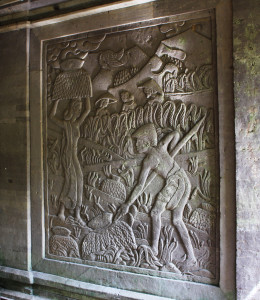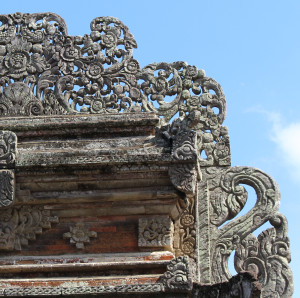This is a draft chapter from my guide Lempad’s Art and Buildings in Bali.

A Boma mask Lempad carved into the lintel of a gate in the outer courtyard. As you can see the outline and features stand out clearly against the intricate background.
Getting there: Ubud’s Royal Palace is on the corner of Jl Raya Ubud and Jl Suweta. It is opposite the Ubud traditional markets and diagonally opposite the Monkey Forest Road and the police station.
This is another private home and for this reason many parts of the palace are not open to the public. However we are all welcome to visit two large courtyards that tend to fill up with dozens of tourists taking selfies by mid-morning. It is a good idea to get here early if you can.
Lempad was the architect and chief sculptor for this palace complex. All of the art you can see here was either made by Lempad himself or under his direction. It was probably his first major work after his father retired.

Bas relief by Lempad on the side of the garage, Peliatan Royal Palace, Ubud, Bali.
Ubud’s king gave Lempad the task in 1917 after the old palace collapsed in an earthquake and a previously-underground stream opened up in its place. The royal family moved to temporary quarters on the site of what are now Ubud’s traditional markets, just over the road from this present-day palace.
While the gates and other architectural features are heavily ornamented Lempad never allowed his figures and faces to become “lost” in the intricate detail of flowers, foliage and scrollwork expected in a temple commission.

Lempad’s filigree stonework on one of the outside gates, Ubud royal palace, Bali.
Lempad was able to express himself more freely with several bas relief panels on less important parts of the buildings. You can see these on the walls of the garage where staff park their scooters. These uncluttered scenes look very much like Ubud-style paintings, a style Lempad also helped develop.
The outer courtyard is also the venue for traditional dances where only the best performers are allowed. If you want to catch a Legong, Barong or Kecak dance here make sure you come nice and early to get a good seat.
You can find more directions to Lempad’s work If you pre-order a copy of my new book here https://www.pozible.com/project/lempad-bali-art-book
